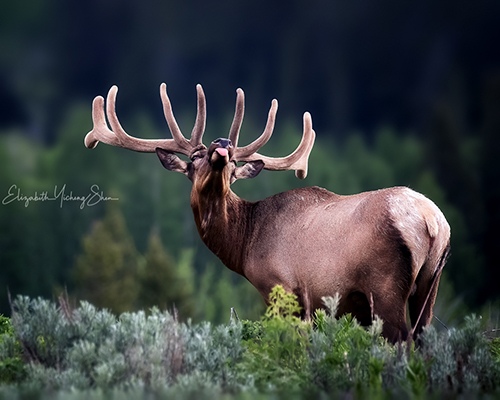Love for Wildlife by Elizabeth Shen
Elizabeth′s love for furry animals began when she met the two family pet rabbits. From them, she learned to love and respect all animals. Afterwards, she volunteered at the House Rabbit Society (HRS), fostered for SaveABunny and The Rabbit Haven and eventually took to wildlife photography. Taking online masterclasses and joining wildlife photography tours helped her to enhance her skills and get closer to wildlife. Be it a rabbit, coyote, or bird, her photos of these animals are extremely captivating. Her way of portraying these animals displays her genuine love for them.
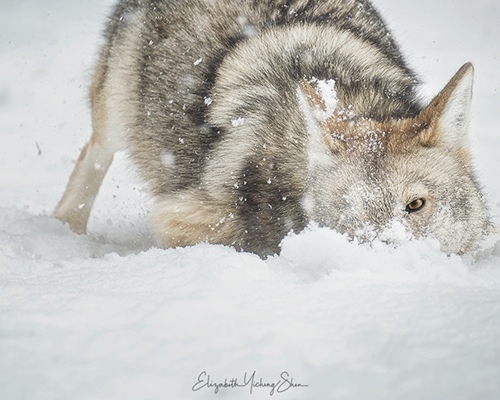
I am so happy to be able to interview her and learn her philosophy regarding wildlife. From the Q&As below, you can see how she developed her love for wild animals and that her care for these animals is deep and admirable. I hope her story and conservation photography can show us a way to be better human beings and love the animals and the environment that we coexist with.
Q: Before you took on photography, what was your educational background and profession?
A: I started my career as a business consultant to which a friend likened to a doctor of businesses. It was my own way to realize a childhood dream to become a doctor. However, without any real-world experiences, I realized my own limitations in terms of the values I could bring to my clients. I also realized that business insights that were equally important as the best practices offered by consultants came from within the company. I, therefore, switched my career and became a finance professional in the tech industry after leaving consulting and completing my MBA.
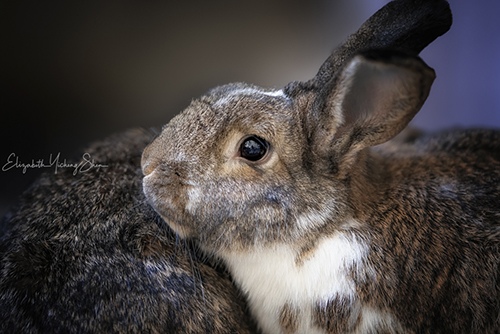
Q: Please share with us your love for animals. Your experience being a foster ″mom″.
A: I spent a lot of my childhood with my grandmother in the countryside. I think it was those early days of sky-staring, tree-climbing, and field-strolling that made me deeply fall in love with nature. However, I didn′t have any animal friends until my sister brought home two baby bunnies, Balloo and Little Beauty, after I started my first job.
We loved them from day one, especially Balloo, who was smart, sweet, mischievous, and brave. Unfortunately, he died at a relatively early age. For the first time, I had to face the loss of someone I loved so much and who taught me the meaning of unconditional love. His passing was such a big shock that brought me to the House Rabbit Society (HRS). That was when I started volunteering and getting involved in rabbit rescue. My time volunteering there was a much-needed bunny therapy. Three months later, I adopted Dusty who has been my inspiration since then…..even though our time together was so short and I′ve spent more time missing him than being with him.
Dusty had a gentle, tender soul. I called him my Buddha bunny who was always so calm, grateful, and forgiving. When I adopted him, I just completed my MBA, struggling to find a job. I gave him a home, but he gave me the much-needed comfort during those days when I felt lost and desperate. I had a lot of wonderful time with Dusty and Addy whom I adopted to keep Dusty company when I started working in Silicon Valley. I loved to see how much they were in love. There was also a moment that Dusty was just a silly goose and didn′t understand Addy′s need for a kiss. Happy times always passed so fast. I still remember that day when Dr. Harvey (the veterinarian who I trust and respect a lot even today) told me that we already reached the end of the road. Dusty was diagnosed with kidney disease and had been under treatment for about 4 months. That was the last time he visited Dr. Harvey. He passed away in my arms just a couple of days later. Even though it was not my first time facing the loss of my furry baby, it was still very difficult. And this time, I also needed to take care of Addy′s feelings. When I put down Dusty′s body next to her, she seemed to know what happened. She gave Dusty her final kisses and then sat quietly next to him.
For anyone who has experienced living with and caring for animals, you would probably agree that animals are sentient beings. They may not have the intelligence of human beings or the understanding of human languages. A lot of them do care about their partners, families, kids, or friends. They have the capabilities to feel sad, mad, afraid, and pain. They are really not that different from us. Inspired by Dusty, I became a foster for rabbit rescues. I wanted to help bunnies like him who would enrich the lives of their future families and inspire more people to love and respect other living things. Gosh! It is really hard to not get attached to your foster bunnies though. I am a foster failure. I ended up adopting 6 out of 10 of my foster bunnies during the past 10 years, on top of my other adopted bunnies. It is never easy to care for a big family of bunnies. However, it is also very fulfilling, knowing that these little guys are healthy and happy, and will have a wonderful life with you.
Most companion animals′ life spans are shorter than ours. They also become excellent teachers to show us the cycle of life: the happiness of birth, the energy of youth, the peace of old age, the sorrow of death. On top of my fireplace, I have eight urns of my furry babies who crossed the Rainbow Bridge. Is it getting easier after facing so much passing of my beloved kids? No, it is never easy nor getting easier. However, I learn to face and accept the cycle of life and cherish every single day being with them. Knowing that each life will come to an end, including mine, I want my life to be a meaningful one.
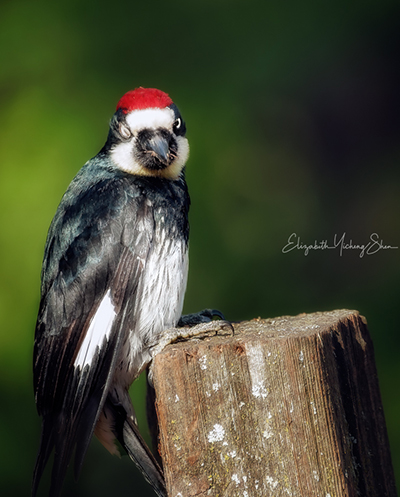
Q: What leads you into photography? Why did you choose wildlife as your focus in your photography?
A: I asked myself from time to time what else I could do for the animals in addition to donating to my favorite charities, volunteering, or fostering for animal rescues. In reality, I was so busy with my job. Even when I had some spare time, I didn′t have the energy nor enough understanding to give my question a deeper thought. It really took way too long to get myself educated. However, the more I learned, the more I realized that I only scratched the surface by focusing on stray animals. The bigger problem and the root cause for not only the animal suffering but also environmental devastation is our unsustainable human-centered lifestyle: our habits, attitudes, moral standards, etc. We rely on animals and this planet for economic prosperity and social vibrancy. But we forget the animals and the planet we rely on also rely on us for ecological sustainability.
If animals and Mother Nature could talk, what would they say to us? What would they want us to know? I, therefore, decided to be the voice of the voiceless. Be their voice and tell their stories. I want them to be heard, their happiness, their sorrow, their life, their plights. I love animals as my own kids and may focus more on wildlife in my photography. However, I love Mother Nature as my own mother and do try to capture her beauty when the opportunity is presented. Conservation Photography is thus an answer to my own quest to understand what else I could do.
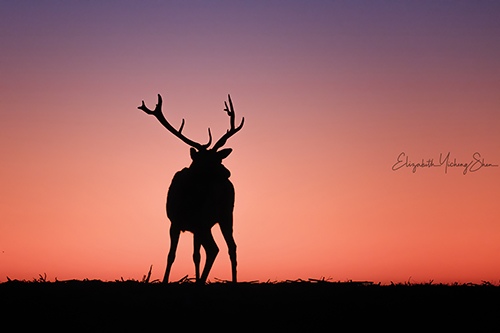
Q: What training you have taken in honing your skills in wildlife photography?
A: The wonderful thing about technology is you can pretty much learn anything online. There are many great photographers around the globe who have the passion to teach and share their knowledge and experiences. Learn from the experts whose work inspires you. That′s my approach.
In my case, I learn almost everything about wildlife photography from Tin Man Lee. I discovered his work about this time two years ago. His photography touches my heart and moves me deeply. So, when I learned that he planned to offer a wildlife photography masterclass and teach me how to capture an image that creates a maximum emotional impact, I knew that class was for me.
Of course, learning how to take pictures is just part of the equation. I also spent a lot of time learning photo editing which is a critical part of wildlife photography as well. In addition to learning Tin Man′s digital editing process, I also took a lot of the photo editing classes offered by Daniel Gastager who is another talented landscape photographer and a great teacher.
With the knowledge learned from these experts, I have taken thousands of images in the wild, edited hundreds of images in front of my computer, and spent countless hours studying my own images. It takes time to find your own style and definitely even more time to create an image that touches people′s hearts.
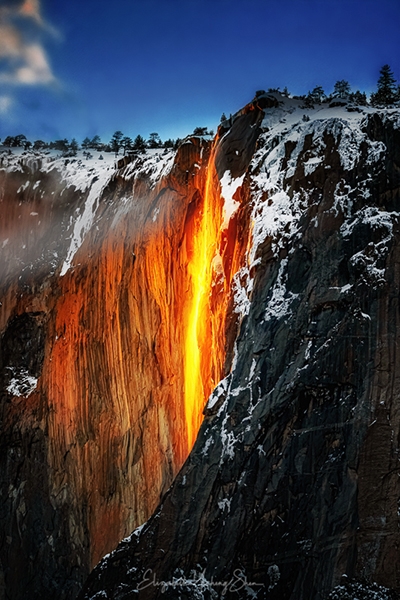
Q: Your love for Yosemite has been expressed vividly in your photoshoots there. Please share with us your experience of taking landscape photos at Yosemite, especially you were able to catch the famed phenomenon of Firefall in Yosemite.
A: Firefall in Yosemite is a natural phenomenon that lasts only 2 weeks usually in late Feb. When the sunset light hits Horsetail Fall on El Captain at just the right angle to create a streak of orange resembling a lava flow. It′s a true natural wonder.
To get to Firefall, a hike from Yosemite Fall couldn′t be avoided last year. I thought there would be a shortcut for this special event other than Valley Loop Trail which was covered by deep snow. Unfortunately, that was where the Ranger sent me. I remembered looking at the trail and then looking back to the ranger.
I said to him, ″I don′t see anyone on the trail.″😨
He gave me a big smile and said, ″Isn′t it nice?″😃
It was a hard hike, an adventure: I never fell that many times in a day, sinking into those powder snow and struggling to get out of it.😩😭It seemed to take forever before I started seeing people again….not on the trail but on Northside Drive which was the shortcut I was looking for. A lane at Northside Drive was closed to vehicles, allowing pedestrians to walk on the road between the viewing area and the parking area. Why didn′t the Ranger sent me to this shortcut? 🙄🤔
Anyway…. it was still a fun experience which I will never forget. And I was very fortunate because Firefall did appear that day. I read somewhere that Firefall only appeared 3 or 4 times in 2019. I don′t think Firefall appeared in 2020 due to the drought in California. I was also told a story about a photographer who went to Yosemite 9 times for Firefall but never saw one. Seeing Firefall does require some luck! I am certainly the lucky one.
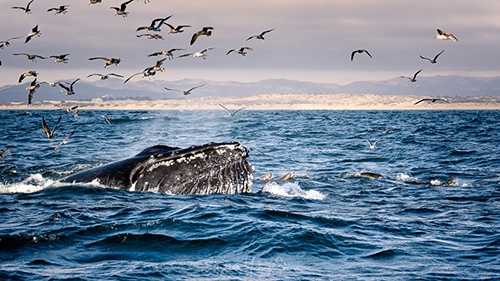
Q: Where have you been in shooting wildlife photos?
A: Since I have 6 bunnies, I don′t travel as much as a lot of wildlife photographers may do. Fortunately, wildlife in the San Francisco Bay Area is abundant. This local focus allows me to get to know the wildlife living near me or around me.
Bay Area lies within The Pacific Flyway which is a major flyway for migratory birds in America. There are varieties of birds to photograph from Autumn to Spring in many wildlife refuges and regional parks around the Bay Area.
Humpback Whales migrate from their winter calving and mating areas off Mexico to their summer and fall feeding areas off coastal California. They can be seen in Monterey Bay from late April to early December. There are also endangered Sea Otters who live in Monterey Bay year-round and can be seen just offshore floating on their backs among the kelp or diving for a meal. There are many other marine animals along the California coast: harbor seal and California sea lion are residents, gray whale and killer whale are transient, and the elephant seal is seasonal.
Point Reyes National Seashore is another amazing place for its breathtaking landscape and amazing wildlife: It has the largest tule elk herds in California. In addition, nearly half the bird species of North America have been spotted there. Over fifty species of animals at Point Reyes are listed by the state or federal government as threatened, rare, or endangered.
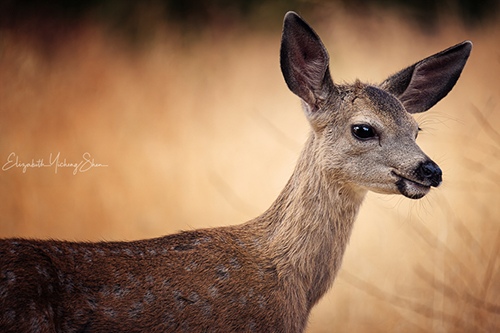
Q: When taking wildlife photos, which is the most difficult part?
A: Finding the animals that you want to photograph is the most difficult part for me. I′ve been to Yellowstone twice since I started wildlife photography. I′ve been searching for one specific kind of animal for which I have a lot of sympathy and respect but haven′t had the chance to photograph. I even hired a professional to help me track them down. Still….no success. That is the wolf.
Q: What advice you would give to beginners for taking wildlife photography.
A: Love and respect your subject first. No harassing, no baiting, no disturbing.
Animals are more important than anyone′s photography.
And don′t ever put yourself in danger. When you put yourself in danger, you also put the animals in danger.
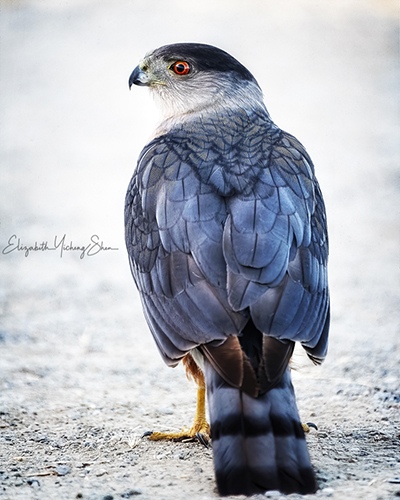
Q: Please share with us your future plan and places you will travel to shoot wildlife photography.
A: I′d love to spend more time in Yellowstone and Grand Teton. Greater Yellowstone is truly heaven for wildlife photographers. I want to photograph wolves, grizzly bear 399 and her cubs, black bears, foxes, elks, bighorn sheep, pronghorns, more coyotes and bison. I also hope to photograph brown bears in Lake Clark, spirit bears in British Columbia, wildlife in Africa, tigers in India, snow monkeys in Japan, polar bears, penguins and etc.
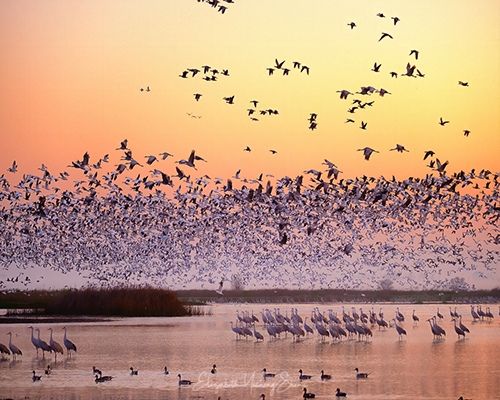
We thank Elizabeth for her sincerity in sharing her path to become a conservation photographer. We look forward to more photo adventures from her.
Elizabeth′s Instagram
